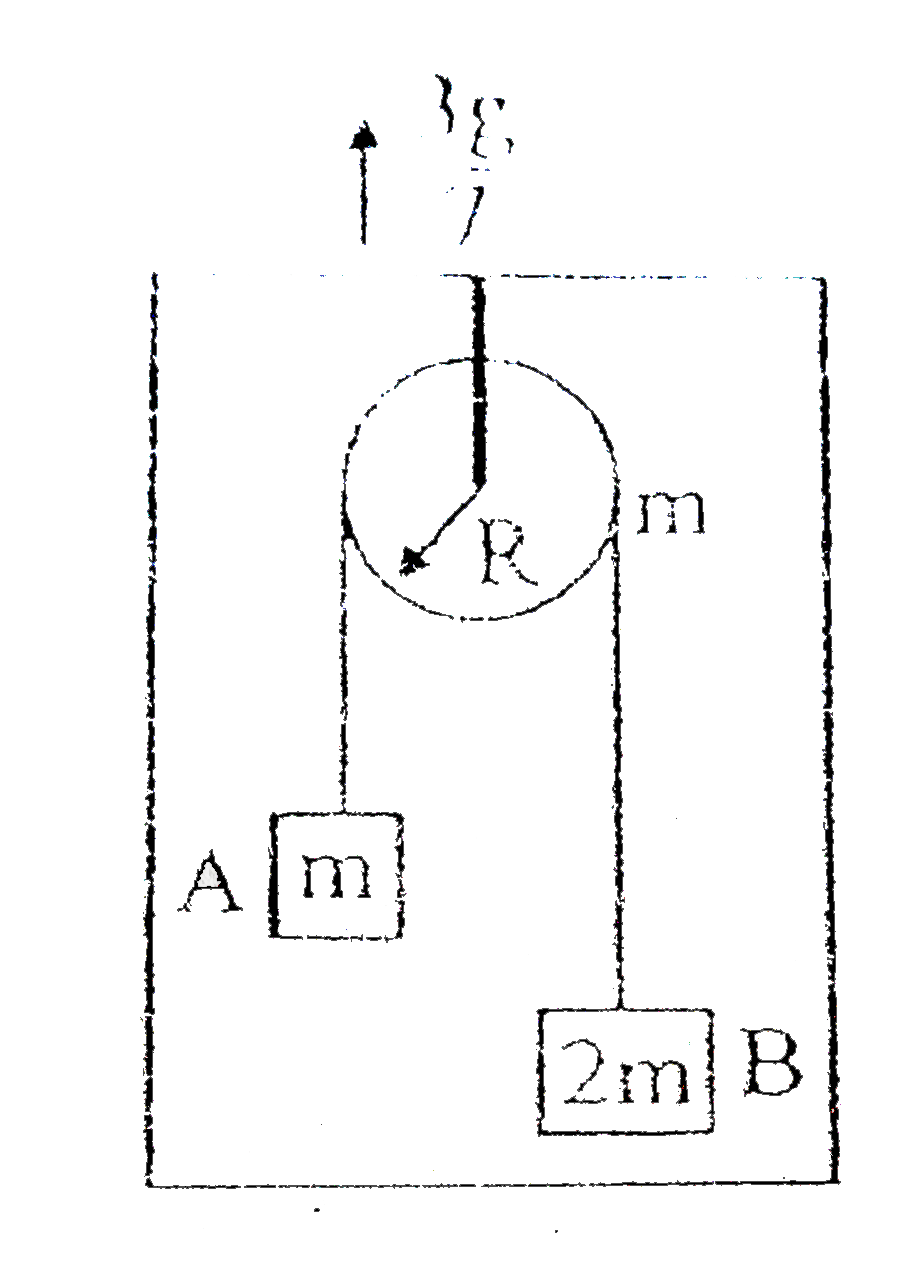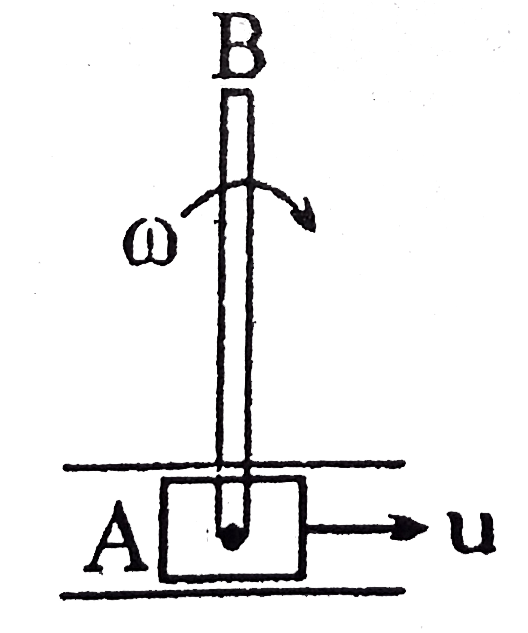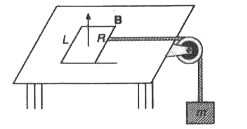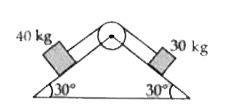A conducting frame is placed in a horizontal plane as shown in the figure. The two sides are parallel and separated by a distance of 0.25 m. A massless conducting rod can slide without friction on the frame. The total resistance of the circuit is 40 Omega. The rod is connected to a 0.2 kg mass by a massless cord which passes over a massless and frictionless pulley. A uniform magnetic field of 2T points vertically upward. The voltage of the bettery is 100 V. Find the constant velocity in m//s with which the rod and mass eventually move.

The correct Answer is:0120
When the rod moves, with constant velocity, net force on the bar is zero
:.W = gravitational force =mg=i/B
[i=induced current in the circuit]
∴I=0.2×102×0.25=4A
To produce 4A current in the bar, induced emf varepsilon in the circuit is 100+ɛ40=4ɛ=60V
We know, ɛ=BlV⇒V=ɛBl=602×0.25=120m/s
Related Playlists
- BOOK - BANSALCHAPTER - MASTER PRACTICE PROBLEMEXERCISE - Additional topic70videos
MASTER PRACTICE PROBLEM
- BOOK - BANSALCHAPTER - MASTER PRACTICE PROBLEMEXERCISE - Multiple objective131videos
MASTER PRACTICE PROBLEM
- BOOK - BANSALCHAPTER - FLUID MECHANICSEXERCISE - PYQS AIEEE10videos
FLUID MECHANICS
- BOOK - BANSALCHAPTER - SEMICONDUCTORSEXERCISE - CBSE Question32videos
SEMICONDUCTORS
Similar Questions
The manifestation of band structure in solids is due to
09:03View SolutionThe quantity// quantities that does //do not have mass in its// their dimentions (when we take standard 7 quantities as fundmental) is//are:
05:07View SolutionA cylinder of height 20m is completely filled with water. The velocity of effux of water (∈ms−1) through a small hole on the side wall of the cylinder near its bottom is
View SolutionHow does the width of the depletion layer of a p-n junction diode change with decrease in reverse bias?
05:16View SolutionMA=3kg,MB=4kg,MC=8kg. Coefficient of friction between any two surface is 0.25 pulley is frictionless and string is massless .A is connected to wall through a massless right rod.
 02:22View Solution
02:22View Solution1 kg and 4 kg blocks lie on a rough horizontal surface. The coefficient of friction between 4 kg blocks and surface is 0.2 while the coefficient of firction between 1 kg blocks and the surface is 0.6 . All the pulley shown in the figure are massless and frictionless and all strings are massless and frictionless and all strings are massless.
View SolutionA pulley is connected to the ceiling of an elevator by a massless rod. Two masses are connected as shown in figure. There is sufficient friction in the pulley axis. The acceleration of block w.r.t. earth is
 04:18View Solution
04:18View SolutionUniform rod AB is hinged at end A in horizontal position as shown in the figure the other end is connected to a block through a massless string m as shown the pulley is smooth and massless masses of block and rod is same and is equal to m then acceleration of block just after release from this position is
 07:07View Solution
07:07View SolutionTwo masses m and m (m>m) are connected by massless flexible and inextensible string passed over massless and frictionless pulley. The acceleration of centre of mass is
11:26View SolutionTwo blocks are connected over a massless pulley as shown in figure. The mass of block A is 10 kg and the coefficient of kinetic friction is 0.2 Block A sliders down the incline at constant speed. The mass of block B in kg is
 View Solution
View SolutionTwo particles of masses m and M(Mgtm) are connected by a cord that passes over a massless, frictionless pulley. The tension T in the string and the acceleration a of the particles is
03:58View SolutionTwo blocks are connected over massless pulley as shown in figure. The mass of block Ais 10 kg and the coefficient of kinetic friction is 0.2 .Block A sliders down the incline at constant speed. The mass of block B in kg is
11:05View Solutionनगण्य प्रतिरोध वाली दो समान्तर क्षैतिज चालक पटरियों को एक सिरे पर लघुपथित करके एक मेज पर जड़ दिया जाता है। पटरियों के बीच की दूरी है। एक द्रव्यमानहीन चालक छड़, जिसका प्रतिरोध है, बिना घर्षण के पटरियों पर फिसल सकती है। छड़ को एक द्रव्यमानहीन डोरी द्वारा मेज के किनारे पर लगी घिरनी (Pulley) के ऊपर से ले जाकर m द्रव्यमान के ब्लॉक से सम्बन्धित किया गया है। मेज के अभिलम्बवत् एक नियत चुम्बकीय क्षेत्र B विद्यमान है। यदि निकाय को विरामावस्था से छोड़ा जाए तो गणना कीजिए
(a) छड़ द्वारा प्राप्त सीमान्त वेग।
(b) जब छड़ का वेग सीमान्त वेग का आधा हो, तब ब्लॉक का त्वरण। 04:15View Solution
04:15View Solution40 किग्रा व 30 किग्रा के द्रव्यमान वाले दो गुटकों को चित्रानुसार एक घर्षणरहित घिरनी पर से एक द्रव्यमानरहित डोरी को जोड़ा जाता है।

निकाय का त्वरण क्या होगा?04:02View SolutionTwo blocks of masses m, = 4 kg and m, = 2 kg connected by a massless rod slide down on an inclined plane of inclination 37degree as shown in figure. If coefficient of friction of m1 and m2 with inclined plane are μ1=0.75andμ2=0.25 respectively, then tension (T) in the rod is (g=10ms−2)
 01:43View Solution
01:43View Solution

